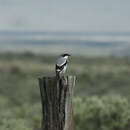mk
имиња во трошки


Perception Channels: visual ; tactile ; acoustic ; chemical
Overall, loggerhead shrikes have a large population size and a large range. One subspecies, the San Clemente loggerhead shrike (Lanius ludovicianus mearnsi) is listed as endangered by the U.S. Fish and Wildlife Service. Also, migrant loggerhead shrikes (Lanius ludovicianus migrans) are listed as endangered in the state of Michigan. Loggerhead shrikes are protected by the U.S. Migratory Bird Act.
US Migratory Bird Act: protected
US Federal List: endangered; no special status
CITES: no special status
State of Michigan List: endangered
IUCN Red List of Threatened Species: least concern
Though not directly having much of an effect either negatively or positively, the fact that the Loggerhead is an endangered species with very specific hunting patterns means that any area in which a Loggerhead is found to reside is instantly zoned for its protection, even if it is a residential area. Such a zoning occured in 1993 in a suburb of Los Angeles.
May eat potentially harmful insects.
Loggerhead shrikes are the only known predatory songbird. They prey on both vertebrate and invertebrate animals, but due to their lack of talons or claws they must impale their prey. Impaling is done with the slightly hooked beak, often against either a tree or into barbed wire. While its diet consists mostly of mice, it will also eat insects, small amphibians, and even small birds.
Prominent in many parts of central Canada, border states of Canada, and in the Greater Midwest of the United States. During its spring / summer migration, however, it can sometimes be seen as far south and west as California though in ever decreasing numbers. For example, its predicted range of migration to and from the state of Indiana is: Arrival from March 15 to 25, and Return from about November 1 to 15.
There are some exceptions to the Shrike's migration, such as its noted presence in the well-suited Florida environment. Thus, habitat and environment are more important in determining migratory patterns for this species than the standard geographic range, especially as suitable hunting grounds become increasingly scarce.
Biogeographic Regions: nearctic (Native )
Except when nesting, both sexes of the species will prefer to spend most of their time in open places hiding in order to search for prey and surprise it. Thus, the Loggerhead will prefer a country field bordered with trees or replete with brush / thickets to almost any other.
Terrestrial Biomes: savanna or grassland
Average lifespan
Status: wild: 150 months.
This shrike is a medium-sized passerine. As with many song birds, the Loggerhead Shrike has several different colors whose arrangement is considered important in attracting a mate (along with displayed hunting prowess). The shrike's greyish back and black wings are evident against its white breast and other body areas. Most prominent, however, is the Loggerhead's black mask which extends around the eyes and down into the forehead. This shrike also has a slightly hooked beak somewhat similar to that of a falcon's beak which is used for impaling its prey, though unlike many birds of prey lacks talong or claws.
It is eight to ten inches long and has a wing span of approximately 12 inches, making it about the size of an average robin.
The male and female of the species are similar in appearance.
Other Physical Features: endothermic ; bilateral symmetry
Average mass: 46 g.
During its April to July breeding season, the male Loggerhead will often kill prey it does not otherwise need in order to display its power. This will hopefully attract a female who seeks a dominant male who is capable of providing food for itself and the offspring.
As for the offspring themselves, nests for eggs are always built in trees, usually about 8 to 15 feet above the ground. The nests are cup-shaped, and house approximately four to seven dull white to light grey spotted eggs.
Key Reproductive Features: iteroparous ; gonochoric/gonochoristic/dioecious (sexes separate); sexual ; oviparous
Average time to hatching: 11 days.
Average eggs per season: 5.